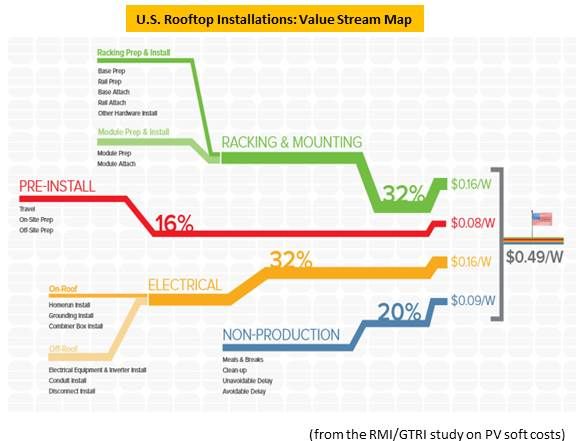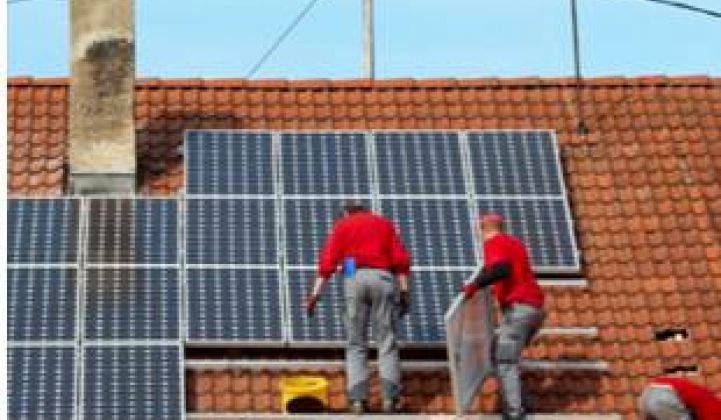“Of the average $4.93 per watt cost of a residential rooftop solar system, over 60 percent of the total is attributable to ‘soft costs,’” according to Reducing Solar PV Soft Cost: Focus on Installation Labor, a joint report from Rocky Mountain Institute and the Georgia Tech Research Institute. “U.S. installers incur median installation costs of $0.49 per watt [but] a composite ‘best of the best’ virtual U.S. installation that draws upon the fastest observed individual installation activities across all U.S. installations would incur installation costs of only $0.29 per watt,” the report concludes.
By comparison, the study reports, the median German installation labor cost is $0.18 per watt.
Researchers used classic time-and-motion study methods to directly observe and document costs incurred by installation labor; permitting, inspection, and interconnection; customer acquisition; financing costs; and installer-integrator margin factors.
According to the report, the biggest cuts in U.S. installation labor costs tend to stem from:
- Adoption of technologies and processes that enable one-day installations
- Overhauling the racking base installation process
- Use of standardized systems that reduce the need for one-off engineering and design work
- Innovating on all AC-related electrical activities
- Eliminating several non-value-add activities typical to the U.S. installation process

But how much can U.S. installers change their practices?
“The biggest cost reduction opportunities are with integrated racking,” according to Cinnamon Solar CEO and veteran installer Barry Cinnamon, “and eliminating the plethora of little nuts, bolts, wires, clips, pieces and parts that don’t add any functional value to the system, but still need to be assembled on the rooftop.”
Some 18,000 jurisdictions and 3,000-plus utilities, as well as uncoordinated local policies, standards, and codes make “a complicated, expensive landscape for rooftop PV,” the study acknowledges, compared to Germany’s $0.03 per watt. U.S. installers have cut permitting, inspection, and interconnection costs 21 percent since 2010, but there is still a cost difference of approximately 50 percent related to racking equipment and hardware between the U.S. and Germany.
"We’ll never get to where Germany is," Cinnamon said. "An example is the suggestion to do away with animal wires. That will only work where there aren’t trees and squirrels. Another is the study’s suggested on-ground preparation. It only works for uniform arrays. And the use of lifts instead of ladders is probably too expensive for most U.S. installers."
The report’s identified goal of doing one-day installations is important because a partial day may cost almost as much as a whole day. But it is tricky to schedule crews only for whole days, Cinnamon said. “If a 5-kilowatt job takes two guys two days, three guys may or may not be able to do it in one day.”

"The report’s stress on integrated racking makes the most sense,” Cinnamon said. “The next generation should have wiring and even inverters built in.” For small roofs, he explained, microinverters cost more but allow installation designs that minimize shade-effects, cut string design layout costs, eliminate high voltage DC dangers, and decrease fire risks.
“The current generation and the next generation of integrated racking are now being standardized,” Cinnamon said. “Zep did that so well that SolarCity bought them.”
“Racking and mounting, at $0.16 per watt, is one of the single largest cost categories for benchmarked rooftop residential installations in the U.S.,” the study reports, and “can have at least a $0.12 per watt impact on the total installed cost.”
Zep competitors that do versions of integrated racking are emerging, like Lumos, Solon, SunPower, Andalay Solar, VeriSol and Cinnamon’s Spice Solar startup. And competing strategies like prefabricated and plug-and-play products are being put in place by companies like PanelClaw, SunLink, and Renusol.
Standardized components are also a crucial next step, Cinnamon said.
“Electrical is done efficiently, because if a job requires extra components, somebody can run out to the local supply store for them,” he said. “Specialized solar components can take three days to procure.”
Market forces are already driving solar standardization, he noted. “Ten years ago, I had to think about modules of different sizes and shapes. Now installers use a standard sized 60-cell module.”



